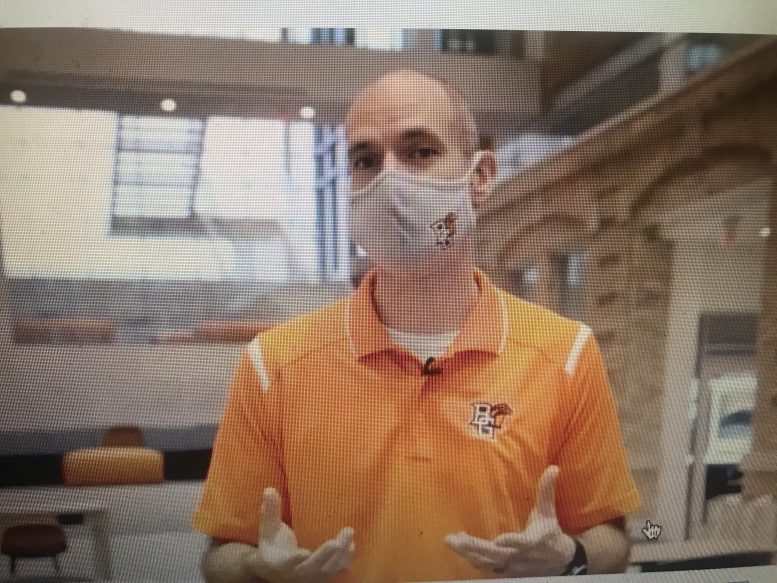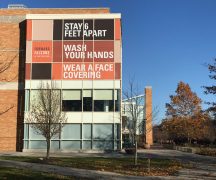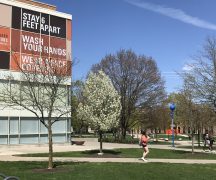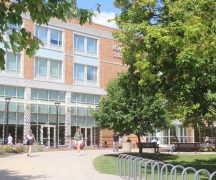By DAVID DUPONT
BG Independent News
The kids are all right.
Bowling Green State University’s Chief Health Officer Ben Batey gave credit to students for the university keeping a lid on COVID-19 cases on campus.
Though his most recent update did show an uptick, he said, that was not “a huge” concern, though it needed to be monitored.
That was nothing like the spike in September, he said Thursday. “I was pleased to see when we saw larger increases in cases in September, we were able to really drastically turn that around.”
Other universities never saw a decline in cases. “For us to be able to turn that curve was a big success.” And Batey said a lot of the credit goes to students who actively worked with the administration when they needed to be quarantined or stay in isolation. (See story and video about students’ response to university’s handling of the pandemic.)
“I think the students have done a fantastic job in really following the protocols,” he said.
Even in the number of police reports of large gatherings over Halloween weekend, Batey sees a silver lining.
The holiday was expected to be problematic, but Batey believes “ it’s nowhere near what you’d have seen in previous years. That’s a win for us.”
Still it is a concern as the Thanksgiving break approaches. That will mark the end of students’ time on campus because they’ll complete the semester online.
Batey has said he doesn’t want students to test positive and then have to delay their holiday plans.
BGSU has also been offering flu shot clinics. That’s all the more important now. “I think all of us have a lot of activities, even if we’re trying to limit our social interactions. There’s still going to be those core family members you’re going to want to spend time with,” he said. “You don’t want to wake up the day before your Christmas holiday get-together with immediate family and have symptoms.”
Is it COVID or is it the flu? Getting a flu shot will help avoid that situation.
Also, the campus protocol is that if someone is feeling sick they need to stay off campus. Not having to worry as much about the flu will keep people from missing activities.
The fight against COVID-19 has also received a boost as top-flight PCR testing capabilities have been ramped up at Wood County Hospital in collaboration with BGSU.
“That’s, in my opinion, truly a game changer,” Batey said.
The test is highly accurate and results will be available within a day. “It’s really going to benefit us for the rest of the semester and into and through spring semester.”
Until recently someone who wakes up with symptoms and gets tested would need to stay inside their household waiting for the results, which would take a week. This is true even if the symptoms were the result of the common cold, and had resolved themselves.
Now that period of uncertainty is greatly shortened.
That allows people who test negative to more quickly get on with their lives.
It also, in the case of a positive test, allows contact tracers from the Department of Health to more quickly get on with the job of finding those the infected person has been around. The infected individual is also able to isolate sooner.
That helps slow down the spread of the virus, Batey said.
This will be a benefit, not just for the hospital and BGSU, but other hospitals in the region that take advantage of the PCR testing.
The university is also increasing the number of quick antigen tests. These are not as reliable, but can be administered more cheaply and quickly.
Batey said before launching this effort they conducted a study by doing an antigen test and a PCR test on the same individuals to see how great the discrepancy is.
The results were reassuring enough that they decided to go ahead with the testing. This will take place over the next couple weeks. Anyone who tests positive will automatically get the PCR test.
In terms of false negatives, Batey said that people need to remember that any test is just a snapshot in time.
Someone could have contracted the virus, but it has not developed enough for the person to test positive.
Even if someone tests negative, they still need to continue to wear a face covering, maintain social distance, wash their hands, and limit their social circles.
“These are the things that will keep you safe over Thanksgiving,” he said.
When students returned to campus in August, there was discussion about whether to send them home if there was a campus outbreak. Batey argued students should stay on campus, lest they spread the virus to other areas.
Now with campus numbers low and cases rising throughout the state, the situation is reversed.
Will students bring COVID back to campus when they return for the spring semester in January?
“That’s a concern,” Batey said. “What does that January return look like? How do we best navigate that? There’s a lot of factors that will have to be taken into account. A lot depends on what’s happening across the state and the nation.”
One thing he knows is that the protocols now in place on campus – the face covering, the classroom set ups, the social distancing, the restrictions on gatherings – will be in place when students return in January.
“These are all things that have proven how we can navigate the core mission of education without having outbreaks,” Batey said.
The problems arise when people spend time with each other. If one person in a household gets the virus, others will as well. That’s true for students, and for community members.
The university also continues to do more intensive testing of groups on campus that cannot follow the protocols, those include athletes, the cheer squad, and the marching band. They spend a lot of time together, and the testing is aimed at spotting any outbreak at the start.
Some concern has been expressed about students being reluctant to get tested if they’re not showing symptoms.
That’s true of the general public, Batey said, not just students.
“We don’t want people to feel like they’re going to be stigmatized if they go to be tested,” he said.
But Batey doesn’t see evidence of a large population of asymptomatic individuals. He gets daily reports on university affiliated patients seeking testing at the Wood County Hospital, and those numbers have not shown an increase, and the positivity rates remain low.
Batey is concerned about any erosion in the public’s trust in public health. When they no longer believe what’s being asked is for the benefit of the whole community, they don’t follow the guidance, and cases go up.
“The more we can get the numbers down, the more we can open up,” Batey said. “The ultimate goal of all of this is to get in the position we can really see low numbers. Then we’ll all feel more comfortable opening up more activities.”





